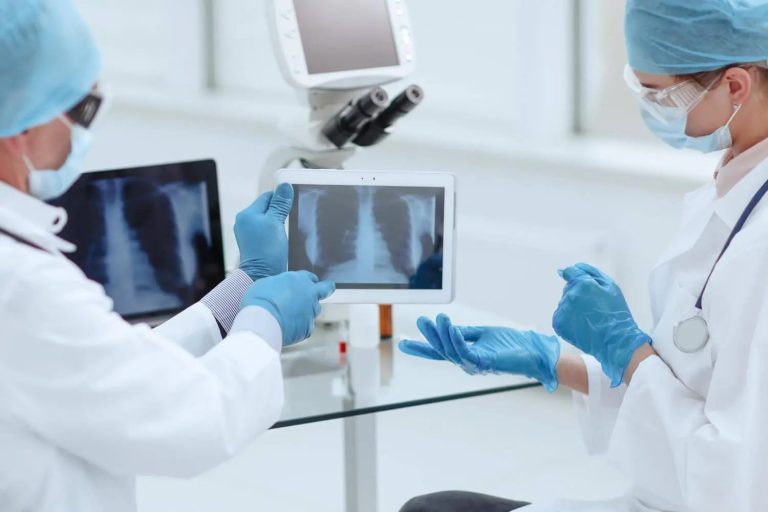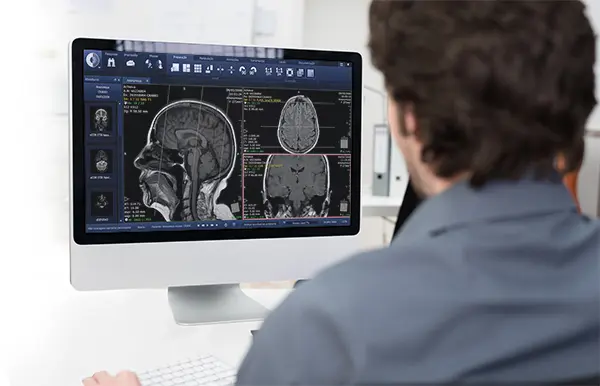The calculation of the Cobb angle can be simplified with the support of technology. To this end, there are software tools designed for the analysis of radiographic images that automate the process.
Pixeon Arya, Pixeon’s diagnostic viewer, automatically calculates the Cobb angle by identifying the terminal vertebrae in just four clicks. This contributes to improving the diagnosis of various conditions, such as scoliosis. Below, learn more about this technology and its advantages in the routine of radiology studies.
How to identify the Cobb angle?
The Cobb angle is a measurement obtained through the Cobb method, which, by drawing two lines on a radiograph, allows the degree of scoliosis in a patient to be identified.
| Cobb Angle Degree | Diagnosis |
| <10° | Not scoliosis |
| 10 – 25° | Mild scoliosis |
| 25 – 45° | Moderate scoliosis |
| > 45° | Severe scoliosis |
In this examination, the physician may also monitor the progress of treatment and the curvature over time. One point of attention is that, depending on the patient’s position during the radiograph, the angle may be altered, compromising the diagnosis.
What is needed for an accurate Cobb angle diagnosis?
The first step toward an accurate scoliosis diagnosis is having the support of technology.
A good image analysis tool allows lines to be drawn on the digital radiograph to automatically obtain orthogonal angles. With just a few clicks, it is possible to assess whether the patient presents scoliosis or not.
The great advantage of a solution like this lies in its usability. Without technology, radiology professionals must perform the process manually on a printed file, which would take between 20 and 30 minutes.
With an automated tool, the result is obtained in less than 10 seconds.
Professionals must be well-trained and position the patient without any type of rotation that could hinder an accurate view. In this way, the image analysis will be clear and effective.
In this regard, it is crucial to correctly identify the terminal vertebrae of the scoliotic curve to determine the Cobb angle. This requires a thorough analysis of the radiographs, which becomes simple and easy with the support of imaging software.
Lastly, it is worth noting that, in addition to the initial diagnosis, regular follow-up with serial studies is required. In this way, it is possible to observe changes in spinal curvature and adjust treatments as necessary.
Optimize your imaging diagnosis: click here to discover secret tools within PACS Aurora.
What are the challenges in identifying the Cobb angle?
The measurement of the Cobb angle considers only variations of the spine in the medio-lateral axis, either to the right or left. However, there are some scoliosis cases in which there are changes in the anteroposterior plane, which are not measured by this tool.
In addition, inaccurate calculations may result in improper estimates of the Cobb angle. This directly impacts the diagnosis and treatment planning.
Pixeon Arya optimizes the entire process of Cobb angle identification. Learn more in the next section.
How does Pixeon Arya facilitate Cobb angle measurement?
Digital radiography and picture archiving and communication systems (PACS) enable radiographs to be accessed, viewed, and analyzed easily from computers.
The parameters for image production are standardized and can be easily accessed, as they impact the diagnostic methodology. All of this enhances the operationalization of medical data.
Pixeon Arya incorporates these standardized features of the medical imaging market and, in addition, offers other benefits as described below. Explore them!
Pixeon Arya is part of the PACS Pixeon Aurora package
The solution integrates with PACS Pixeon Aurora, which allows the storage, distribution, and reconstruction of images with solutions for every stage. Arya focuses on the diagnostic visualization of radiological images, ensuring centralized, high-quality images and the access physicians require.
The software also includes specialized resources for cardiology, mammography, nuclear medicine, gastroenterology, and oncology. The graphic and photographic methods allow for the direct storage and visualization within PACS of graphic and photographic results (MAPA, Holter, endoscopies, vulvoscopies, etc.).
Additionally, it offers tools for multiple specialties, such as:
- Kinetic curve in magnetic resonance imaging;
- 2D fusion of multiple series and modalities, with negative mode, blending, and addition;
- Multiplanar reconstruction (MPR), with MIP, MiniP, and Curve methodologies;
- 3D reconstruction, with specialized settings for airways, bones, and soft tissues.
Diagnostic tools
In addition to standard visualization—which allows for adjustments such as brightness, contrast, and zoom—the solution offers diagnostic tools for working with the image, such as the Cobb angle itself.
Other orthopedic solutions supported by PACS Pixeon Aurora include: TA-GT distance (patellar dislocation analysis), femorotibial angle (anatomical axis analysis of the lower limb), patellar index, and automatic vertebra detection.
Access to Equipment-Specific Tools
One of the major benefits of Pixeon Arya is access to tools that were previously available only on certain devices. The solution’s interoperability allows the radiologist to analyze the image without the need to be on-site or to rely on a specific device.
Would you like to take advantage of Pixeon Arya and increase medical productivity? Contact our specialists and discover everything about award-winning and innovative systems designed to optimize your radiology management.
About Pixeon
Pixeon is the company with the largest software portfolio for the healthcare market.
Our solutions serve hospitals, clinics, laboratories, and diagnostic imaging centers, covering both management (HIS, CIS, RIS, and LIS) and diagnostic processes (PACS and Laboratory Interface), ensuring high performance and top-tier management in healthcare institutions.
The HIS/CIS software for hospitals and clinics, Pixeon Smart, is a complete solution that integrates the entire institution into a single system. It is also certified with the highest level of digital maturity by SBIS (Brazilian Society of Health Informatics).
We already have over 3,000 clients in Brazil, Argentina, Uruguay, and Colombia, serving millions of patients annually through our platforms.
Want to know if Pixeon’s technologies offer everything you’ve always wanted for your hospital or clinic?
Request a commercial consultation and be amazed by everything our management system can provide!










